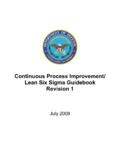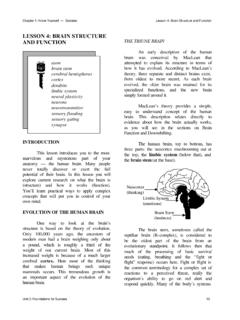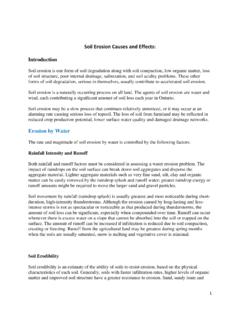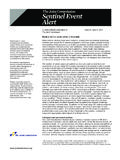Transcription of DATA COLLECTION - Air University
1 Basic Tools for Process Improvement Module 7. data COLLECTION . data COLLECTION 1. Basic Tools for Process Improvement What is data COLLECTION ? data COLLECTION helps your team to assess the health of your process. To do so, you must identify the key quality characteristics you will measure, how you will measure them, and what you will do with the data you collect. What exactly is a key quality characteristic? It is a characteristic of the product or service produced by a process that customers have determined is important to them.
2 Key quality characteristics are such things as the speed of delivery of a service, the finish on a set of stainless steel shelves, the precision with which an electronic component is calibrated, or the effectiveness of an administrative response to a tasking by higher authority. Every product or service has multiple key quality characteristics. When you are selecting processes to improve, you need to find out the processes, or process steps, that produce the characteristics your customers perceive as important to product quality.
3 data COLLECTION is nothing more than planning for and obtaining useful information on key quality characteristics produced by your process (Viewgraph 1). However, simply collecting data does not ensure that you will obtain relevant or specific enough data to tell you what is occurring in your process. The key issue is not: How do we collect data ? Rather, it is: How do we obtain useful data ? Why do we need to collect data ? Every process improvement effort relies on data to provide a factual basis for making decisions throughout the Plan-Do-Check-Act cycle.
4 data COLLECTION enables a team to formulate and test working assumptions about a process and develop information that will lead to the improvement of the key quality characteristics of the product or service. data COLLECTION improves your decision-making by helping you focus on objective information about what is happening in the process, rather than subjective opinions. In other words, I think the problem The data indicate the problem (Viewgraph 2). Why do we need a well-defined data COLLECTION process? For your team to collect data uniformly, you will need to develop a data COLLECTION plan.
5 The elements of the plan must be clearly and unambiguously defined . operationally defined. You may want to pause here and review the Operational Definitions module before you go on. Why does a team need Operational Definitions in order to collect useful data ? Let's say three people are collecting data on the time it takes to perform a certain process step. Unless the exact moment when each action begins and the exact moment 2 data COLLECTION . Basic Tools for Process Improvement What Is data COLLECTION ? data COLLECTION is obtaining useful information.
6 The issue is not: How do we collect data ? It is: How do we obtain useful data ? data COLLECTION VIEWGRAPH 1. Why Collect data ? To estabish a factual basis for making decisions I think the problem is .. becomes The data indicate the problem is .. data COLLECTION VIEWGRAPH 2. data COLLECTION 3. Basic Tools for Process Improvement when it ends are operationally defined, each data collector will observe and record data based on his or her own understanding of the situation. The data COLLECTION process will not be standardized or consistent.
7 You will have collected data , but it probably won't be much good to you. Worse yet, you may make changes to your process based on flawed information. data COLLECTION can involve a multitude of decisions by data collectors. When you prepare your data COLLECTION plan, you should try to eliminate as many subjective choices as possible by operationally defining the parameters needed to do the job correctly. It may be as simple as establishing separate criteria and a specific way to judge when a step begins and when it ends.
8 Your data collectors will then have a standard operating procedure to use during their data COLLECTION activities. When should we develop a data COLLECTION plan? You should develop your data COLLECTION plan during the Plan Phase of the Plan-Do- Check-Act (PDCA) cycle. The PDCA cycle provides a framework for you to build an understanding of your process and how to obtain and interpret data that will lead to real process improvement. Although they can be time-consuming, planning sessions are extremely important because this is when you establish the guidance that helps you obtain the right data .
9 What questions should the data COLLECTION plan answer? Your team needs to develop the answers to the following questions as the basis for a sound data COLLECTION plan: ! Why do we want the data ? What will we do with the data after we have collected them? The team must decide on a purpose for collecting the data (Viewgraph 3). In the Plan Phase, your team should develop a working hypothesis which will serve as a guide to future investigation of the process. This hypothesis is an assumption based on already existing data and observations, such as your process Flowcharts or a Cause-and-Effect Diagram the team has prepared.
10 You develop working assumptions and collect data to determine the process changes that will improve the key quality characteristics of your product or service. Your proposed change should be stated as an "If .. then" statement. IF we change Step X in our process by doing .., we believe we will THEN improve Y, which is a key quality characteristic of our product or service. 4 data COLLECTION . Basic Tools for Process Improvement Making a data COLLECTION Plan Why do we want the data ? What purpose will they serve?
















